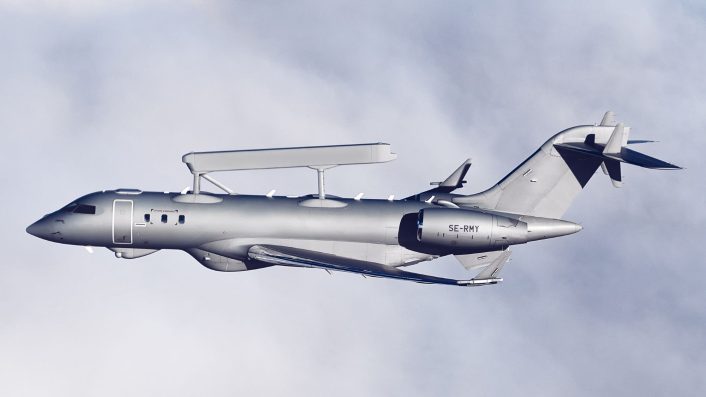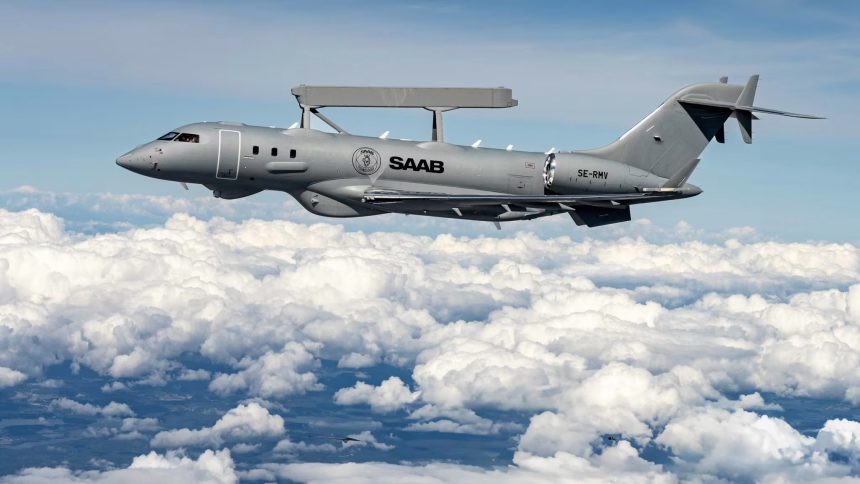The joint declaration of intent includes two GlobalEyes and an option for two additional aircraft.
After a year of speculation and reports about France having chosen Saab’s GlobalEye AEW&C (Airborne Early Warning and Control) aircraft to replace the older E-3F Sentry AWACS, Paris and Stockholm’s defense ministers signed a letter of intent (LOI) on Jun. 18, 2025 at the ongoing Paris Air Show for acquiring two units of the platform. With an option for two more included, both Saab and France’s Direction générale de l’armement (DGA) specified this is not a final contract.
A LOI was also signed between the DGA and MBDA for the latter’s Akeron MP anti-tank guided missile. This follows a Jan. 31, 2024 LOI between MBDA and Saab concerning the Akeron MP’s procurement for both the Swedish and the French armed forces.
The agreements are therefore long in a line of burgeoning diplomatically-driven defense and strategic cooperation between the two countries, and the broader “joint declaration” between French defense minister Sébastien Lecornu and his Swedish counterpart Pål Johansson covers a host of other naval and surface-to-air systems.
RELEASE: 🇫🇷 France announces intention to procure GlobalEye
Joint declaration of intent regarding the sale of Saab’s GlobalEye Early Warning and Control (AEW&C) aircraft to France signed with @DGA. #AEWC #defence #parisairshow https://t.co/t8V7WYSAc6 pic.twitter.com/2UEiwrpHlX
— Saab (@Saab) June 18, 2025
A major translation of the elevating ties reflected in the French Air and Space Force’s (Armée de l’Air et de l’Espace) beginning its annual Pégase (Pegasus) deployment in Apr. 2025 at Luleå in Sweden, home of the Norrbotten Wing F 21.
The FASF’s four E-3F Sentry AWACS aircraft, first delivered in the early 1990s, are beset with maintainability issues. The other operators of the type, including the U.S. Air Force and the North Atlantic Treaty Organization (NATO), are also looking to replace the aging platform.
The Letter of Intent
While mentioning that the joint declaration of intent also includes an option for two additional aircraft, Saab clarified that the “parties have not yet entered into a contract and Saab has not yet received an order for GlobalEye from France.” In fact, a final notification process and a contract will follow in the coming months.
The French defense procurement body, the Direction générale de l’armement (DGA), called the overall agreements signed by Lecornu and Johansson as a “roadmap” for “strengthening cooperation between the two countries in the field of armaments.” It then listed the GlobalEye from Saab and the Akeron MP anti-tank missile from MBDA covered under the letter of intent.
Le suédois Saab et la DGA signent une déclaration d’intention sur l’achat par la France de deux avions d’alerte et contrôle (AEW&C) GlobalEye, plus deux en option. Contrat finalisé ces prochains mois par la DGA, selon Saab pic.twitter.com/PShUqotxxT
— Vincent Lamigeon (@VincentLamigeon) June 18, 2025
Beside the “air surveillance” and an “anti-tank missile framework,” the DGA said the “cooperation” is also about “the Meteor missile, medium-range (Aster missile) and short-range air defense, the defence and intervention frigate as a candidate system for the Swedish next-generation surface ship program, innovation, as well as the security of ammunition and explosive supplies.”
Saab’s president and CEO Micael Johansson said in the company’s statement that the GlobalEye AEW&C “will enhance the French Armed Forces’ situational awareness and threat detection across the air, land and sea domains.” He further added “Our solution will enable France to maintain full sovereign control of its airborne early warning and control capability.”
Additionally, Saab has also signed a framework agreement with the French aircraft maintenance and modification provider Sabena technics for the GlobalEye’s aircraft modification work. “Transforming the airframe into a GlobalEye platform involves extensive technically complex work which requires highly-skilled and dedicated personnel,” says the company, and this agreement will cover “complex aircraft modification and associated services for GlobalEye.”
“This reenforces Saab’s commitment to collaborate with French industry while supporting the expansion of our modification capacity to meet the increasing demand for GlobalEye. Sabena technics has the expertise and experience to provide this support,” says Lars Tossman, head of Saab’s business area Aeronautics.
Saab GlobalEye
The company describes GlobalEye as an “advanced multi-domain AEW&C aircraft” carrying an “array of active and passive sensors,” which provides “long-range detection and identification of objects in the air, at sea and over land.” Additionally, “by providing real-time information to air forces, armies and navies, GlobalEye enables enhanced situational awareness of the surrounding areas and early detection of threats,” Saab said.

The DGA, meanwhile, said the GlobalEye “represents a new airborne capability for surveillance, air traffic control and command and control (C2) of air operations.” The statement further added “It is capable of operating in a degraded/contested environment, in a multinational and inter-allied framework. It allows for a very rapid response to the operational needs of the Air and Space Force without causing a capability gap.”
Saab’s S 106 GlobalEye AEW&C aircraft is derived from the company’s Erieye airborne radar system carried on the Saab 340 AEW, Saab 2000 AEW, and Embraer E-99 aerial platforms. In the case of GlobalEye, Erieye is installed on the Canadian-made Bombardier Global 6000/6500 aircraft family, Saab says.
The Erieye is based around the PS-890 AESA (Active Electronically Scanned Array) radar, mounted on a distinctive ‘plank’ above the carrier aircraft’s fuselage. According to Jane’s, it enables a detection range of up to 450 km for fighter-sized aircraft, depending on altitude and the radar cross section.
Along with AEW&C capability, the upgraded Erieye ER system offers maritime surveillance with a Leonardo SeaSpray 7500E radar, assisted by a FLIR Systems Star Safire 380-HD EO/IR turret. It also has a GMTI (Ground Moving Target Indication) capability.
France wants to turn to the Swedish @Saab GlobalEye to replace its Awacs planeshttps://t.co/HH3WuPBH7f pic.twitter.com/pk6iatwn51
— Fly High Aeromedia (@FHAeromedia) January 30, 2024
Dassault’s Falcon 10X is out
The development also finally lays to rest the jostling by French aerospace major Dassault Aviation for considering its Falcon 10X as the carrier aircraft for Paris’ next AEW&C. The company’s chief Éric Trappier pushed the domestic option in a hearing before the country’s lawmakers in the National Assembly. The first Falcon 10X ultra-long range business jet is in the final assembly stage at the company’s Bordeaux-Mérignac facility, and is looking at a late-2027 service entry.
🇸🇪🇫🇷A strong collaboration between Sweden and France strengthens NATO’s collective defence. France today communicated its intent to acquire 4 Global Eye aircraft. This will benefit our countries & deepen interoperability. We also signed a road map on further defence cooperation. pic.twitter.com/M2WTAOyoHl
— Pål Jonson (@PlJonson) June 18, 2025
Intelligence Online reported in July 2024 about Paris having “finalized” a deal with Stockholm, but so far no formal announcement was made in this regard. These reports also followed the visit of a GlobalEye in France in April 2024, flying for five days from Mont-de-Marsan Air Base (BA118).
The base is home of the Centre d’Expertise Aérienne Militaire (CEAM), which develops and tests new and/or upgraded systems for the French Air and Space Force. The issue was also believed to have been discussed during French President Emmanuel Macron’s Jan. 2024 visit to Sweden.
#DassaultAviation lance le #Falcon 10X, le plus avancé et le plus spacieux des avions d’affaires https://t.co/ZzCDu4ibz0
Dassault Aviation Launches #Falcon10X, featuring Industry’s Largest Cabin and Most Advanced Technology on a Business Jet https://t.co/rvq5Zvrtvq pic.twitter.com/HqhYbwtiPd
— Dassault Aviation (@Dassault_OnAir) May 6, 2021
That same month, French newspaper Les Échos also said that the Falcon 10X satisfied all the requirements for the E-3F’s replacement, but implementing the GlobalEye system is a “long-term project to Europeanize a major air defense system.” These developments clearly suggested a deal was in the offing.









